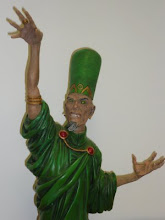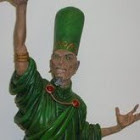 Second issue of an engaging fantasy series that moves the story forward with confident storytelling. Corvan Moore, a law enforcement office in Cog Town had discovered a horrible event at the end of issue one. Corvan starts out to deal with this and finds that he is getting deeper and deeper into trouble and danger for himself and others.
Second issue of an engaging fantasy series that moves the story forward with confident storytelling. Corvan Moore, a law enforcement office in Cog Town had discovered a horrible event at the end of issue one. Corvan starts out to deal with this and finds that he is getting deeper and deeper into trouble and danger for himself and others.Raven Nevermore has two stories running at the same time, the upfront story of Corvan More and his fight with a criminal organisation in CogTown. The there is a second story that in running underneath this one. In issue two these two stories start to cut across each other more explicitly as it revealed that Corvan knows less than he should and others know more. This places Convan at a very dangerous disadvantage and leads to a terrible result.
Nuno Xei writes with wonderful confidence, moving from one story to another with assurance and deft skill, this allows the reader to relax into the story and enjoy the hints and revelations as they arise. The suspense is carefully created and maintained as the cast become more diverse and the circumstances considerably more dangerous and threatening.
Xerx Javier art is friendly and engaging, the cast move though the crowded streets and strange drains of Cog Town with physical force and impact. The lovely costumes give the scenes a great sense of place and time that hold the story firmly in place. There is a mix of historical context and science fiction, fantasy that is all presented as natural and coherent.
The colouring is crucial to the success of the story, it bring out the details of the art , gives force to the action, and captures the emotional context for the action. Axel Rator uses muted colours to bring the different elements of the story together with understated skill.
Ed Brisson letters with care and attention to detail that allows the words to flow in the artwork, reveal the story and cat without ever interrupting the action.
Samuel Cassal cover is a joy, it announces the work of a very talented group pf creators with force.
There is a very enjoyable glossary at the end of the issue which I read with pleasure, the details gave a greater depth to the world of Raven Nevermore.
Raven Nevermore is unfolding in a most intriguing and engaging way, I am very happy to be along for the ride.







